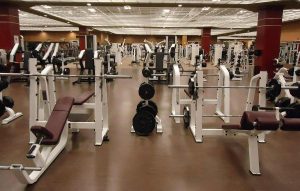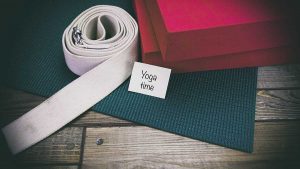 So you have joined a gym? Awesome and what a great step towards a new and improved you.
So you have joined a gym? Awesome and what a great step towards a new and improved you.
The equipment is state-of-the art and the space is wonderfully air conditioned, but what really swayed it for you during your membership joining spiel was the packed class schedule – unlimited with lots of choice including yoga!
Fabulous :) You are now technically SAVING money as you no longer need to join the yoga studio down the street. That’s hard earned pennies back in the pocket.
Or is it?
Admittedly this post is based on my experience and own research, but from what I know and have learnt there is a big difference between yoga classes in a gym and classes at a designated studio.
Focus in a gym is to keep fit and stretch
As most of you studio yogis know, there is more to yoga than the physical focus. In a gym class people want to feel like they have worked hard whether that’s through sweating or stretching every muscle they possibly can. I have found that most classes I have attended in a gym tend to fit into the ‘power yoga’ category or they are very much a stretching session. Both are great but they only touch the surface of what yoga is actually about and studio classes offer the opportunity to explore the more spiritual and mindful side to your practice.

A well varied studio schedule will have dedicated pranayama classes as well as restorative options to balance the yin and yang of your yoga experience. While this isn’t for everyone, I can say that my mindful yoga journey quite often outweighs the benefits of my physical journey.
Gym yoga classes tend to be more informal
Yoga classes in a gym will rarely use sanskrit. As a teacher, I always use sanskrit as well as the ‘english’ name of the poses regardless of where I am teaching purely out of habit but my students in the gym often laugh at my use of ‘funny’ words to explain what pose we are currently practising. It’s not something that strikes me as that important but as a student if I know the name of the pose and I hear the incorrect name even in English it does make me sometimes question the authenticity of the teacher I am learning from. Whether this matters in a gym class and to the ordinary student just wanting a stretch I don’t know, but in my experience, a good yoga teacher should at least know what Warrior pose is!
 There is also less focus on proper alignment in a gym class. This does frustrate me as I was taught that in order to practise safely you need to have a good knowledge of alignment principles, particularly if you are attending classes regularly. Again, this is something I do teach whether in a gym or a studio purely on the basis to help others avoid injury. I like to adjust as this is how I was taught, but a hands-on approach tends not to happen in a gym and is more a ‘follow the teacher’ situation. Of course this is absolutely fine, but having experienced hands on adjustment as a student myself, I know I prefer to have that little extra help and guidance I sometimes can’t find by myself.
There is also less focus on proper alignment in a gym class. This does frustrate me as I was taught that in order to practise safely you need to have a good knowledge of alignment principles, particularly if you are attending classes regularly. Again, this is something I do teach whether in a gym or a studio purely on the basis to help others avoid injury. I like to adjust as this is how I was taught, but a hands-on approach tends not to happen in a gym and is more a ‘follow the teacher’ situation. Of course this is absolutely fine, but having experienced hands on adjustment as a student myself, I know I prefer to have that little extra help and guidance I sometimes can’t find by myself.
There is also no requirement to arrive early for a class in the gym. If people arrive late it’s ok, and there is no need for pre meditation or relaxation before a class starts. I have even had students have their phones go off which is something that doesn’t really happen in a studio. There are usually strict rules about leaving phones in lockers and switched off and I have even been in classes where they lock the door as soon as class starts not allowing anyone to enter to disturb others once the class begins. This was in a studio in China as I think a few people would have fire safety concerns if that happened in this country.
The atmosphere is different
As soon as you walk into a yoga studio I give it 30 seconds before you find a buddha statue, an ‘ohm’ sign or the smell of incense, or of course all three. There is a sense you are in a place not quite ordinary anymore.
More often than not, in a studio you are asked to leave your shoes at the entrance and people talk quietly respecting others’ need for quiet meditation before practice.

In a gym, this is definitely not the case. Life is ‘normal’ so to speak and the smell is usually of sweat and sound of people pounding the running machines and the ellipticals – definitely less ‘zen’ but then it’s a gym and people are there for more reasons than yoga. I love that sense of calm you get before a class begins and have been known to turn up to class even half an hour early (yes I’m that student!), especially if I am joining a hot yoga or Bikram class. I use the time to open up my shoulders and whatever area happens to be tight that day finishing with some ‘me’ time. Everything feels quiet and at peace, a feeling that is very hard to cultivate these days.
The air conditioning is usually on quite high in a gym especially the fancier, bigger chains. Yoga studios tend to be warmer and if you are practising Bikram the temperature is even HOT. This helps relax the muscles to access deeper stretches and for my own personal preference I love a warmer environment when I practise but I can’t deny to occasionally turning on the Dyson fan during a challenging power yoga session. It is hard to get the temperature right for classes in a gym. Compared to that of a studio, people only practise yoga whereas you may have a yoga class in a gym that is immediately followed by Spinning and you need to feel as cool as possible if you ever decide to try that.
Class Length and Type
Gym classes usually take place first thing in the morning before the working day and again around 4pm for those finishing a day at the office. They are at ‘peak’ times unless you are really lucky and are members of a gym where classes are non-stop throughout the day.
The classes take place one after the other with no time before or after like an ‘in and out’ system. They are usually 45 minutes long or an hour and very rarely longer than that. A yoga studio class is anything from an hour to 90 minutes, sometimes even 2 hours with Mysore being even longer.
In a gym, class type is quite limited. It is either a power yoga class with a core focus or a flexibility style class with a stretch focus. There are so many more styles of yoga than that. By joining a yoga studio you have access to so many more styles and while some types of yoga do overlap in terms of style they each have their own distinct methods and way of learning.
In Shanghai, I was fortunate to have an unlimited membership at My Soul Yoga Studio and it opened my eyes to how many different classes were available. My beautiful studio was open at least 14 hours daily and still didn’t cover all the styles that exist. As a passionate yogini I was in my element and my experience there opened my eyes to so much yoga. My membership allowed me to try as many different styles as I physically could and which classes I loved and which were not quite suited to me and ultimately led me on a path to the teacher training. Happy days :)
I began my journey thinking it was all about getting a nice stretch with the occasional contortionist challenge, but realise it is so much more than that and even if I had 100 lifetimes I still wouldn’t be able to master all I wanted to. It is a very humbling concept and I actually quite like that even though I am a teacher and love sharing what I know about yoga, I will still always be a student on a constant path of learning and self discovery.
Props and equipment
In a studio, you will be spoilt for choice for props. You want 4 blocks, 2 straps and a bolster? No problem, help yourself. You know how tight your body is and what you need in your practice on any given day so you ‘prop up’ accordingly.
 In a gym props aren’t really available and if they are people do not know how to use them. There isn’t really a need for bolsters as classes are not usually restorative. If the gym is well equipped there will be straps and maybe even some blocks but this doesn’t happen very often. Just bear in mind if you do like using props in your practice, then it may be worth investing in your own if you are joining a gym yoga class but see what your gym has before you part with your hard earned cash.
In a gym props aren’t really available and if they are people do not know how to use them. There isn’t really a need for bolsters as classes are not usually restorative. If the gym is well equipped there will be straps and maybe even some blocks but this doesn’t happen very often. Just bear in mind if you do like using props in your practice, then it may be worth investing in your own if you are joining a gym yoga class but see what your gym has before you part with your hard earned cash.
Another issue that has come up during my gym yoga classes is that of mats. As a teacher, I am very particular about the mat I practise on and so usually use my own. Like anything, equipment gets used ALOT and it goes without saying it is always better to have your own mat. There is loads of information online about choosing a mat and you can spend as little or as much as you like. We would all like to think mats get cleaned regularly but not only yogis are using mats. The mats are for everyone – even those lifting weights wearing their not-so-clean trainers.
That doesn’t mean to say studio mats are any better. Regardless of where you are practising, mats wear out and often have been used by many people. If you don’t fancy investing in a mat I would recommend buying a decent yoga towel to put on top of your mat. That way, when the teacher guides you into a Child’s Pose you don’t need to hold your breath when your face is so close to the mat.
Improving your level
A yoga studio schedule will have a number of different styles but there will also be a guide about the level a class is pitched at whether it be Beginner, Intermediate, Advanced or suitable for all levels. There will be modifications for any class you try but it is quite nice to be able to choose what level you want to practise at and whether you want to be challenged. In my old studio there were even some classes where you had to ask permission from the instructor to join and he/she would decide whether you were ready to join a higher level class.
If you attend a studio class regularly, you are likely to progress more as your teacher will get to know you and your abilities and help you improve your practice and as a result, your level.
Gym yoga classes will be suitable for all levels unless they stipulate otherwise. They have to be because they are catering for everyone – all ages, different levels of fitness and flexibility. I have sometimes found I need to up the ante for a deeper stretch as I know what my body needs but I am lucky as I know what options are available in any given pose. In a mixed level class some will be challenged and unsure how to use props to help them with their progression, and those more flexible but ‘stuck’ on a pose because a deeper option hasn’t been made available and again stuck at the same level unable to progress.
Savasana
 Savasana is the most important pose in any practice, but is often missed out in a gym class, partly because time is so short or most people attending the class are also checked in for the next one so the last thing they want to do is completely relax.
Savasana is the most important pose in any practice, but is often missed out in a gym class, partly because time is so short or most people attending the class are also checked in for the next one so the last thing they want to do is completely relax.
In a studio you can expect your Savasana to be anything from 5-15 minutes and often ending with the class chanting Ohm or maybe there is some sort of singing bowl action. This truly is a wonderful way to end your practice and one I personally prefer. It helps seal in the benefits and bring you back to the present in a relaxed manner.
Many people do not understand Savasana and it’s importance. During my gym sessions people often get up and leave early which I get as there are people to see and places to go, but it does disturb others and something I would not encourage particularly if I was teaching in a studio.
So which is best?
To be honest, ‘best’ is probably a bad way to phrase it and of course it depends on personal choice. If there isn’t much yoga in your area, gym classes provide a wonderful opportunity to experience an introductory avenue into yoga and whether it is something you want to explore further.
While I am reluctant to talk about ‘authenticity’ as it potentially sounds like I am implying one option is not, it is true to say that your experience in a studio feels more so.
As for what is better that is purely down to you. Many find the spiritual atmosphere of a studio intimidating and off putting while others feel a gym class is more focused on burning calories than the actual yoga journey.
At the end of the day if you have joined a gym and your classes are free try it out and enjoy as you have nothing to lose, but don’t close yourself off from experiencing yoga in a studio as it is very different. Broaden your horizons and get as much variety in your yoga as you possibly can – your mind and body will thank you for it.
Namaste
Vic xox
The information provided on this website is for educational purposes only and in no way represents any form of medical or physical advice. By making use of this content, you are participating at your own risk. You should consult a doctor or physician before attempting any form of exercise or poses to ensure you do not injure yourself as a result. By making use of this website, you agree that Sida Yoga accepts no liability whatsoever for any damages or injuries howsoever caused.

